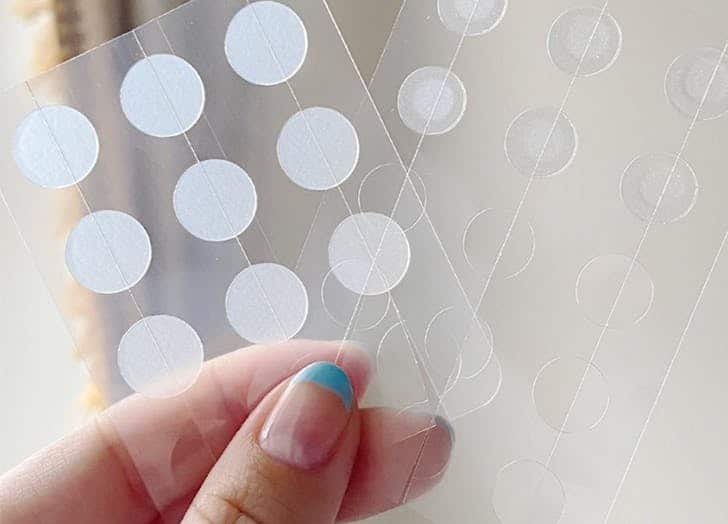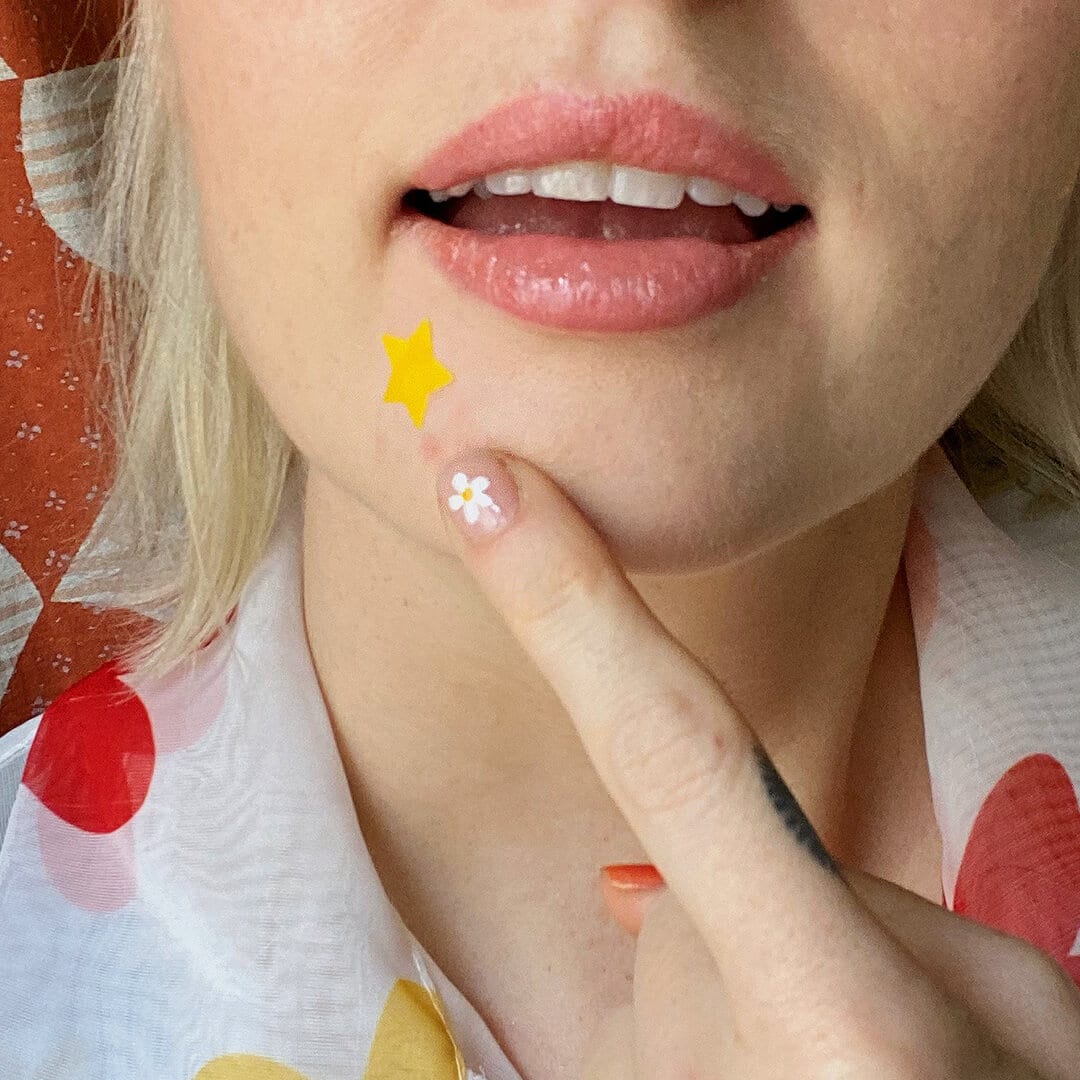Hydrocolloid Patches- Are They Great For Pimples?
Hydrocolloid patches or acne patches are great to remove acne. Don’t let the size of acne patches fool you. These tiny acne patches are gentle giants for treating spots when used correctly.
Science has done great work in introducing acne blemish stickers in the form of hydrocolloid patches. First, let me tell you, acne patches are of 3 different types. Whether or not they have ingredients and what ingredients they have will determine when they should be used. Knowing when to use these hydrocolloid patches is the key to getting great results and a clear complexion free of pimples.
This is a guide based on acne treatments available. This will help you determine if the acne patches or hydrocolloid patches are right for your skin or not and which one you should be used to treat acne.
What Are Acne Patches?

Acne patches also referred to as hydrocolloid patches, pimple patches, acne stickers, and spot patches that are small stick dots used for treating acne spots. Their overall work or job is to fast forward the pimples or helps controlling damage after causing issues when you pop a pimple.
There are mainly three different types of acne patches or pimple patches. These are:
- Medicated patches.
- Micro dart patches
- Hydrocolloid patches
All these are called spot patches and pimple patches but the only difference between these are the ingredients used in each one. Here is a brief about hydrocolloid patches:
- Pimple patches work on skin surface acne like blackheads and pus-filled pimples but they should not be used for cystic acne.
- They are prepared with zit drying hydrocolloid and some other products that have acne-fighting properties and ingredients.
- You should consult a doctor before using these and find the most effective acne treatment plan for your skin type.
History of hydrocolloids
Hydrocolloid patches for acne are some of the most popular patches out there currently and for their effective working, they are highly popular. Hydrocolloid patches go way back in the history of medicines and have been into account for treating various wounds for decades. You might be thinking that these are useful for treating wounds, how can they treat acne? Let’s see how.
When you get a scrape or bleeding cut, the first thing that comes into your mind is a dry bandage. However, many studies have shown that that is not a good thing to do. More and more scientists and researchers are siding with various studies that indicate a moist environment can encourage fast healing and maybe healing faster.
When you are having a wet wound like a bleeding cut or a nasty burn, the blood and secretions go into the badge applied. Using a dry bandage such as gauze, these secretions will dry the bandage and might get stuck to the skin which makes them quite to be removed.
The idea of applying damp bandages over wounds was first cropped in Ancient Egypt, where they used grease-covered to protect the sounds and heal them. This is not an ideal method to heal wounds, but of course, it is still better than using nothing at all.
But in the 1960s a super effective method was sued for treating wounds using a wet bandage and the term hydrocolloid was introduced. Hydrocolloid patches or bandages work by using a specific gel substance to draw out nasty bacterias and pus from the wounds while remaining wet enough to not remain stuck to the healing wound. Earlier, they were used on things like ulcers and stomas and were proven to be extremely beneficial.
Hydrocolloid Patches For Pimples

So, now you know how hydrocolloid bandages came into account and how they work in the medical world, but how do hydrocolloid patches work on your face to heal pimples? let’s find out.
Several studies have proven that hydrocolloid patches are excellent at absorbing wound secretions thus helping the wounds to speed up the process of healing. When you get down to it, pimples are also little wounds on your face. Wounds are injuries that break your skin which is the same as what pimples do to your face.
Pimples form when the bacterias causing acne, dead skin cells, and excess oils block the pores. This further causes inflammation, redness, and irritation forming a lesion sometimes. This area of your skin looks abnormal compared to the surrounding skin.
Hdroiccoloid patches work best for removing ballon-like pimples. They usually absorb the nastiness that is present beneath the skin surface that helps blemish to heal. they are excellent because they can be used on all skin types.
These cushiony and round hydrocolloid patches have water-binding groups within their structure that help prevent the loss of water from the skin. This further acts like a bubble of protection to keep leftover creator or blemishes moist thus helping promote and speed up the healing process.
If you have an unknown obsession with picking spots and popping pimples, you already know what damage can be done. Long-term scarring as a result of a small pimple is no joke. But. we understand it is hard to resist and not to squeeze pimples. Luckily, using a pimple patch will stop you in between, keeping your bacteria-laden fingers at bay so that your skin can heal itself quickly.
Hydroilcolid patches are highly favored among professionals for healing wounds, this should tell you a lot about how effective hydrocolloid patches are. They are just a part of some silly trend that will vanish over time, they are something that the doctors recommend all around the globe for decades and now they are effective for blemishes too.
How to use acne patches in your skincare regimen
While you might not require to use hydrocolloid patches daily, they are great to be used when you have acne. You should use them blemishes that are difficult to treat and you want to reduce quickly.
Since these patches have to adhere to the skin to work best, it is best to apply them when the skin is completely dry. Wash your face to ensure you are placing them on clear and dry skin. Apply them after washing your face and before using other products like sunscreen or moisturizer.
Hydrocolloid patches for spots must be replaced very often. they are okay to be worn up to 24 hours daily for up to 21 days or so. If your hydrocolloid patches have already absorbed a bunch of dirt, you may have to replace them sooner.
What Else To Look For?
As per experts, there are few other ingredients you must look for. Ingredients like benzoyl peroxide and salicylic acid are great ingredients to look for in acne treatment. These are great staples to treat acne.
Deeper acne-like painful and large-sized pimples trapped beneath the skin will likely need a cortisol injection or some other treatment that pimple patches cannot deliver.
Board-certified dermatologists refer to using non-medicated versions of the pimple patches. Experts suggest you apply patches to clean and dry your face as the first step in your skincare regimen.
Can Hydrocolloid patches fight stigma?
The feeling of growing self-consciousness over growing pimples or zits is a universal feeling and experience. One way these hydrocolloid patches help fight this use is by treating acne spots discreetly. Other products like star-shaped stickers are not about hiding the acne, they are more abt accepting your acne.
If you have acne and it bothers you immensely, you should visit a dermatologist to get your skin on track. Acne is not smoothing you can get rid of in a day or two, it needs months of treatment to work well.
Are there risks to using hydrocolloid patches?

Thankfully, the risk associated with using hydrocolloid patches is very less unless you are allergic to one of the many ingredients present inside these patches. If you have highly sensitive skin, the adhesives might be a bit irritating especially when you wear them at night.
Pimple Patches For Cystic Acne
Know that not all acne can be treated using hydrocolloid patches. The efficiency of these hydrocolloid patches highly depends on the type of pimple you have.
- If you have a cystic acne problem, you will want to go or hydrocolloid patches or pimple patches that have salicylic acid with calming agents like Vitamin E and green tea. While salicylic acid helps dissolve the debris clogging your pores and soothing the ingredients and trying out in the process.
- Hormonal acne mainly begins just before the menstrual cycle, stock o for pimple patch with anti-inflammatory and antioxidant ingredients.
- If you have whiteheads, you will need a pimple patch having beta hydroxy acids that sts through the oil-prone regions and penetrate deep inside clogged pores.
The Bottom Line
Acne patches really work great for most acne and pimples on all skin types. No, you cannot expect the pimples to go overnight and they will not undo the damage completely after you have popped a pimple as usual. But they are highly useful in treating zits, speed up the healing process, calm inflation due to pimples, and most importantly they make you feel highly productive.
We know how maddening it is to wait for your pimples to get over because you wish to attend a party or function and cannot show up with huge zits. Pimples patches can help you deal with that too, making it a lifesaver.
This was everything about hydrocolloid patches and how they work amazingly well for most acne types.

